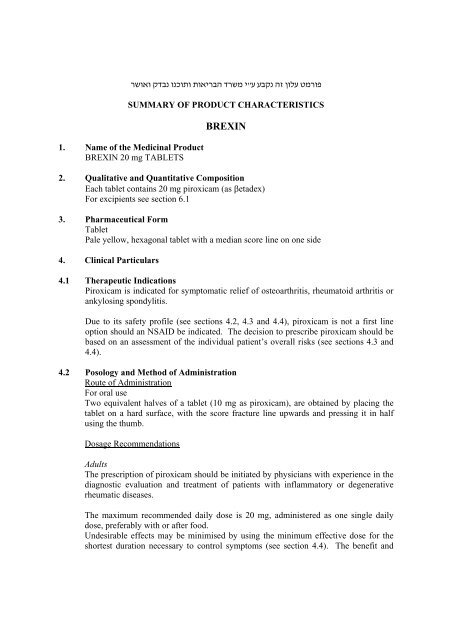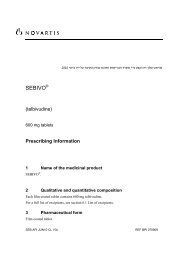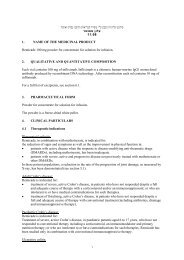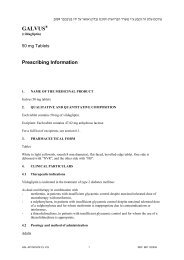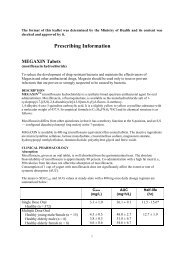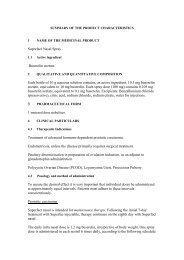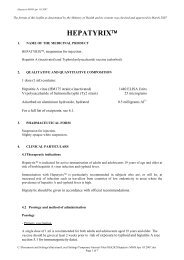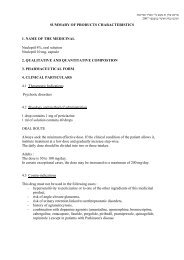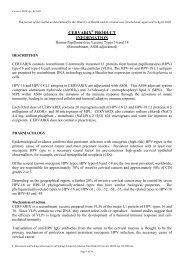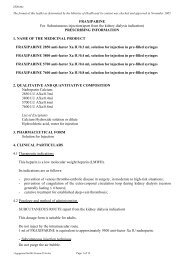BREXIN
BREXIN
BREXIN
Create successful ePaper yourself
Turn your PDF publications into a flip-book with our unique Google optimized e-Paper software.
רשואו קדבנ ונכותו תואירבה דרשמ י " ע עבקנ הז ןולע טמרופ<br />
SUMMARY OF PRODUCT CHARACTERISTICS<br />
1. Name of the Medicinal Product<br />
<strong>BREXIN</strong> 20 mg TABLETS<br />
<strong>BREXIN</strong><br />
2. Qualitative and Quantitative Composition<br />
Each tablet contains 20 mg piroxicam (as βetadex)<br />
For excipients see section 6.1<br />
3. Pharmaceutical Form<br />
Tablet<br />
Pale yellow, hexagonal tablet with a median score line on one side<br />
4. Clinical Particulars<br />
4.1 Therapeutic Indications<br />
Piroxicam is indicated for symptomatic relief of osteoarthritis, rheumatoid arthritis or<br />
ankylosing spondylitis.<br />
Due to its safety profile (see sections 4.2, 4.3 and 4.4), piroxicam is not a first line<br />
option should an NSAID be indicated. The decision to prescribe piroxicam should be<br />
based on an assessment of the individual patient’s overall risks (see sections 4.3 and<br />
4.4).<br />
4.2 Posology and Method of Administration<br />
Route of Administration<br />
For oral use<br />
Two equivalent halves of a tablet (10 mg as piroxicam), are obtained by placing the<br />
tablet on a hard surface, with the score fracture line upwards and pressing it in half<br />
using the thumb.<br />
Dosage Recommendations<br />
Adults<br />
The prescription of piroxicam should be initiated by physicians with experience in the<br />
diagnostic evaluation and treatment of patients with inflammatory or degenerative<br />
rheumatic diseases.<br />
The maximum recommended daily dose is 20 mg, administered as one single daily<br />
dose, preferably with or after food.<br />
Undesirable effects may be minimised by using the minimum effective dose for the<br />
shortest duration necessary to control symptoms (see section 4.4). The benefit and
tolerability of treatment should be reviewed within 14 days. If continued treatment is<br />
considered necessary, this should be accompanied by frequent review.<br />
Given that piroxicam has been shown to be associated with an increased risk of<br />
gastrointestinal complications, the possible need for combination therapy with gastroprotective<br />
agents (e.g. misoprostol or proton pump inhibitors) should be carefully<br />
considered, in particular for elderly patients.<br />
Children<br />
The use of piroxicam in children is not recommended.<br />
The Elderly<br />
In elderly patients, it may be necessary to reduce the dosage (half a tablet), and limit<br />
the duration of treatment. Again, it is preferable to take the dose with or after food.<br />
NSAIDs should be used with particular caution in elderly patients who are more prone<br />
to adverse events.<br />
4.3 Contra-indications<br />
- known hypersensitivity to any of the constituents or piroxicam<br />
- history of gastro-intestinal ulceration, bleeding or perforation<br />
- patient history of gastrointestinal disorders that predispose to bleeding disorders<br />
such as ulcerative colitis, Crohn’s disease, gastrointestinal cancers or diverticulitis<br />
- patients with active peptic ulcer, inflammatory gastrointestinal disorder or<br />
gastrointestinal bleeding<br />
- concomitant use with other NSAIDs, including COX-2 selective NSAIDs and<br />
acetylsalicylic acid at analgesic doses<br />
- concomitant use with anticoagulants<br />
- history of previous serious allergic drug reaction of any type, especially cutaneous<br />
reactions such as erythema multiforme, Stevens-Johnson syndrome, toxic<br />
epidermal necrolysis<br />
- hypersensitivity to the active substance, previous skin reaction (regardless of<br />
severity) to piroxicam, other NSAIDs and other medications<br />
- porphyria<br />
- severe heart failure<br />
Brexin is contra-indicated in children.<br />
4.4 Special Warnings and Precautions for Use<br />
Undesirable effects may be minimised by using the minimum effective dose for the<br />
shortest duration necessary to control symptoms (see section 4.2).<br />
The clinical benefit and tolerability should be re-evaluated periodically and treatment<br />
should be immediately discontinued at the first appearance of cutaneous reactions or<br />
relevant gastrointestinal events.<br />
Gastrointestinal (GI) Effects, Risk of GI Ulceration, Bleeding and Perforation
NSAIDs, including piroxicam, can cause serious gastrointestinal events including<br />
bleeding, ulceration, and perforation of the stomach, small intestine or large intestine,<br />
which can be fatal. These serious adverse events can occur at any time, with or<br />
without warning symptoms, in patients treated with NSAIDs.<br />
NSAID exposures of both short and long duration have an increased risk of serious GI<br />
event. Evidence from observational studies suggests that piroxicam may be associated<br />
with a high risk of serious gastrointestinal toxicity, relative to other NSAIDs.<br />
Patients with significant risk factors for serious GI events should be treated with<br />
piroxicam only after careful consideration (see sections 4.3 and below).<br />
The possible need for combination therapy with gastro-protective agents (e.g.<br />
misoprostol or proton pump inhibitors) should be carefully considered (see section<br />
4.2).<br />
Serious GI Complications<br />
Identification of at-risk subjects<br />
The risk of developing serious GI complications increases with age. Age over 70<br />
years is associated with high risk of complications. The administration to patients<br />
older than 80 years should be avoided.<br />
Patients taking concomitant oral corticosteroids, selective serotonin reuptake inhibitors<br />
(SSRIs) or anti-platelet agents such as low-dose acetylsalicylic acid are at increased<br />
risk of serious GI complications (see below and section 4.5). As with other NSAIDs,<br />
the use of piroxicam in combination with protective agents (e.g. misoprostol or proton<br />
pump inhibitors) must be considered for these at-risk patients.<br />
Patients and physicians should remain alerted for signs and symptoms of GI ulceration<br />
and/or bleeding during piroxicam treatment. Patients should be asked to report any<br />
new or unusual abdominal symptom during treatment. If a gastrointestinal<br />
complication is suspected during treatment, piroxicam should be discontinued<br />
immediately and additional clinical evaluation and treatment should be considered.<br />
Cardiovascular and cerebrovascular effects<br />
Appropriate monitoring and advice are required for patients with a history of<br />
hypertension and/or mild to moderate congestive heart failure as fluid retention and<br />
oedema have been reported in association with NSAID therapy.<br />
Clinical trial and epidemiological data suggest that use of some NSAIDs (particularly<br />
at high doses and in long term treatment) may be associated with a small increased<br />
risk of arterial thrombotic events (for example myocardial infarction or stroke). There<br />
are insufficient data to exclude such a risk for piroxicam.<br />
Patients with uncontrolled hypertension, congestive heart failure, established<br />
ischaemic heart disease, peripheral arterial disease, and/or cerebrovascular disease<br />
should only be treated with piroxicam after careful consideration. Similar<br />
consideration should be made before initiating longer-term treatment of patients with<br />
risk factors for cardiovascular disease (e.g. hypertension, hyperlipidaemia, diabetes<br />
mellitus, smoking).
To avoid the risk of increased side effects, piroxicam should not be given with other<br />
non-steroidal anti-inflammatory agents.<br />
In patients with renal, cardiac or hepatic impairment, caution is required since the use<br />
of NSAIDs may result in deterioration of renal function. Assessment of renal function<br />
in such patients, should occur prior to the initiation of therapy and regularly thereafter.<br />
Piroxicam may cause a decrease in platelet aggregation and prolongation of bleeding<br />
time. This effect should be kept in mind when bleeding times are determined.<br />
As NSAIDs can interfere with platelet function, they should be used with caution in<br />
patients with intracranial haemorrhage and bleeding diathesis.<br />
Caution is required if piroxicam is administered to patients suffering from or with a<br />
previous history of bronchial asthma since NSAIDs have been reported to cause<br />
bronchospasm in such patients.<br />
There are reports of reversible elevation of blood urea, nitrogen and creatinine.<br />
In rare cases, NSAIDs may cause interstitial nephritis, glomerulitis papillary necrosis<br />
and nephrotic syndrome. They inhibit synthesis of renal prostaglandin that plays a<br />
supportive role in maintaining renal perfusion in patients with reduced blood volume<br />
and renal blood flow. In such patients, administration of a NSAID may precipitate<br />
overt renal decompensation, which is followed by recovery to the pre-treatment state<br />
upon discontinuation of NSAID therapy. Patients at greatest risk of such a reaction<br />
are those with congestive heart failure, liver cirrhosis, nephrotic syndrome or overt<br />
renal disease. Such patients should be monitored carefully whilst receiving NSAID<br />
therapy.<br />
Skin reactions<br />
Serious skin reactions, some of them fatal, including exfoliative dermatitis, Stevens-<br />
Johnson syndrome, and toxic epidermal necrolysis, have been reported very rarely in<br />
association with the use of NSAIDs (see section 4.8). Evidence from observational<br />
studies suggests that piroxicam may be associated with a higher risk of serious skin<br />
reactions than other non-oxicam NSAIDs. Patients appear to be at highest risk of<br />
these reactions early in the course of therapy, the onset of the reaction occurring in the<br />
majority of cases within the first month of treatment. Piroxicam should be<br />
discontinued at the first appearance of skin rash, mucosal lesions, or any other signs of<br />
hypersensitivity.<br />
4.5 Interactions with Other Medicaments and Other Forms of Interaction<br />
Care should be taken in patients treated with any of the drugs mentioned below<br />
because, as with other NSAIDs, piroxicam has the potential to induce the following<br />
interactions.
Other Analgesics<br />
As with other NSAIDs, the use of piroxicam together with acetylsalicylic acid or<br />
concomitant use with other NSAIDs, including other piroxicam formulations, must be<br />
avoided, since data are inadequate to show that such combinations produce greater<br />
improvement than that achieved with piroxicam alone; moreover, the potential for<br />
adverse reactions is enhanced (see section 4.4). Human studies have shown that<br />
concomitant use of piroxicam and acetylsalicylic acid reduces the plasma piroxicam<br />
concentration to about 80% of the usual value.<br />
Anti-hypertensives<br />
There may be a reduction in the effect of anti-hypertensives.<br />
Diuretics<br />
Piroxicam may cause sodium, potassium and fluid retention, and may interfere with<br />
the natriuretic action of diuretic drugs causing a reduction in the diuretic effect.<br />
Diuretics can increase the risk of nephrotoxicity of NSAIDs. These properties should<br />
be kept in mind when treating patients with compromised cardiac function or<br />
hypertension, to avoid a possible worsening of these conditions.<br />
Cardiac Glycosides<br />
NSAIDs may exacerbate cardiac failure, reduce GFR and increase plasma cardiac<br />
glycosides levels.<br />
Concomitant administration of antacids had no effect on piroxicam plasma levels, nor<br />
did concurrent therapy of piroxicam with digoxin or digitoxin affect the plasma levels<br />
of either drug.<br />
Sulphonamides and Hydantoins<br />
Piroxicam is highly protein bound, and therefore, it might be expected to displace<br />
other protein bound drugs e.g. anticoagulants, sulphonamides and hydantoins such as<br />
phenytoin. Patients must be monitored closely for change in dosage requirements<br />
when giving Brexin to patients already receiving other highly protein bound drugs.<br />
Anticoagulants<br />
NSAIDs, including piroxicam, may enhance the effects of anti-coagulants, such as<br />
warfarin. Therefore, the use of piroxicam with concomitant anticoagulant such as<br />
warfarin should be avoided (see section 4.3).Brexin.<br />
Anti-platelet agents and selective serotonin reuptake inhibitors (SSRIs)<br />
Increased risk of gastrointestinal bleeding (see section 4.4).<br />
Cimetidine<br />
There is some evidence that a slight but significant increase in absorption of piroxicam<br />
may occur following administration of cimetidine - with no significant changes in<br />
elimination rate constants or half-life. It is unlikely that this small increase in<br />
absorption is of clinical significance.
Lithium<br />
NSAIDs, including piroxicam, have been reported to decrease the elimination of<br />
lithium. It is recommended that the levels of lithium are monitored when initiating,<br />
adjusting or discontinuing treatment with piroxicam.<br />
Quinolone Antibiotics<br />
Animal data indicate that NSAIDs can increase the risk of convulsions associated with<br />
quinolone antibiotics. Patients taking NSAIDs and quinolones may have an increased<br />
risk of developing convulsions.<br />
Mifepristone<br />
In common with other NSAIDs, piroxicam should be avoided for at least 8 to 12 days<br />
following mifepristone administration as NSAIDs can reduce the effect of<br />
mifepristone.<br />
Methotrexate<br />
There is decreased elimination of methotrexate with NSAIDs.<br />
Ciclosporin<br />
NSAIDs may increase ciclosporin nephrotoxicity as a result of their effect on renal<br />
prostaglandins.<br />
Corticosteroids<br />
Increased risk of gastrointestinal ulceration or bleeding (see section 4.4).<br />
Aminoglycosides<br />
Reduction in renal function in susceptible individuals, decreased elimination of<br />
aminoglycosides and increased plasma concentrations have been reported.<br />
Probenecid<br />
Reduction in metabolism and elimination of NSAID and metabolites occurs with<br />
probenecid.<br />
Oral Hypoglycaemic Agents<br />
Inhibition of metabolism of sulfonylurea drugs, prolonged half-life and increased risk<br />
of hypoglycaemia is known to occur with oral hypoglycaemic agents.<br />
4.6 Pregnancy and Lactation<br />
Although no teratogenic effects have been demonstrated in animal toxicology studies,<br />
the use of NSAIDs during pregnancy should, if possible, be avoided. Congenital<br />
abnormalities have been reported in association with NSAID administration in man.<br />
However, these are low in frequency and do not appear to follow any discernible<br />
pattern.
Piroxicam inhibits prostaglandin synthesis and release through a reversible inhibition<br />
of the cyclo-oxygenase enzyme. This effect, as with other NSAID, is associated with<br />
an increased incidence of dystocia and delayed parturition in pregnant animals when<br />
drug administration was continued into late pregnancy. NSAIDs are also known to<br />
induce closure of the ductus arteriosus in infants and therefore, use in late pregnancy<br />
should be avoided.<br />
A study indicates that piroxicam is found in breast milk at about 1 % to 3 % of the<br />
maternal plasma concentrations. No accumulation of piroxicam occurred in milk<br />
relative to that in plasma during treatment for up to 52 days. Brexin is not<br />
recommended for use in nursing mothers because clinical safety in neonates has not<br />
been established.<br />
4.7 Effects on Ability to Drive and Use Machines<br />
Piroxicam can alter the state of alertness to such an extent that driving vehicles or<br />
performing activities which require quick reflexes (such as operating machinery),<br />
may be affected.<br />
Since swollen eyes, blurred vision and eye irritation have been reported in association<br />
with the use of piroxicam, and dizziness, drowsiness or headaches are possible side<br />
effects associated with taking NSAIDs, patients should be warned to take care when<br />
undertaking such activities.<br />
Although routine ophthalmology and slit-lamp examinations have not shown evidence<br />
of ocular changes such examinations should be performed if these symptoms develop.<br />
4.8 Undesirable Effects<br />
Gastrointestinal<br />
Gastrointestinal symptoms associated with piroxicam administration are the most<br />
common side effects, but in most cases do not interfere with continuation of therapy.<br />
These include ulcerative stomatitis, anorexia, epigastric or abdominal discomfort or<br />
pain, nausea, constipation, flatulence, diarrhoea and indigestion, vomiting, dyspepsia,<br />
melaena and haematemesis.<br />
Gastric ulceration, duodenal ulcer and gastrointestinal perforation and gastrointestinal<br />
bleeding, in rare cases fatal, have been reported with piroxicam. Long-term<br />
administration of piroxicam in a dose of 30 mg per day or more carries an increased<br />
risk of gastrointestinal side effects.<br />
Hypersensitivity Reactions<br />
There are rare reports of piroxicam causing cutaneous hypersensitivity reactions such<br />
as rash or pruritus, urticaria, angioedema, onycholysis or alopecia. As with other<br />
NSAIDs, epidermal necrolysis (Lyell’s disease), Stevens-Johnson syndrome or<br />
vesiculo-bullous reactions may occur rarely.
These reactions may also consist of respiratory tract reactivity comprising of asthma,<br />
aggravated asthma, bronchospasm or dyspnoea.<br />
There may be other non-specific allergic reactions and anaphylaxis.<br />
Other hypersensitivity reactions such as vasculitis and serum sickness have been rarely<br />
reported.<br />
Dermatological Reaction<br />
Photosensitivity reactions occur infrequently.<br />
Renal<br />
Rarely, NSAIDs may cause interstitial nephritis, glomerulo-nephritis, nephrotic<br />
syndrome and renal failure.<br />
Haematological Reactions<br />
Decreases in haemoglobin and haematocrit in the absence of obvious gastrointestinal<br />
bleeding have occurred and anaemia has been reported, as have thrombocytopenia,<br />
non-thrombocytopenic purpura (Henoch-Schoenlein), leucopenia and eosinophilia.<br />
There are rare reports of aplastic anaemia, haemolytic anaemia and epistaxis.<br />
Hepatic<br />
Changes in various liver function parameters have been seen with piroxicam and, as<br />
with other NSAIDs, some patients may show an increase in serum transaminase<br />
concentration during piroxicam treatment; also, severe hepatic reactions, including<br />
jaundice and cases of fatal hepatitis have also occurred.<br />
Even though such events are rare, where abnormal liver function tests persist or<br />
worsen or clinical signs consistent with liver disease develop, or there are systemic<br />
manifestations (such as a rash or eosinophilia), treatment should be discontinued.<br />
Cardiovascular<br />
Oedema, hypertension, and cardiac failure, have been reported in association with<br />
NSAID treatment.<br />
Equally, elderly, frail or debilitated patients require careful supervision because they<br />
may tolerate side effects less well; the elderly require caution since they are more<br />
likely to have impaired renal, hepatic or cardiac function.<br />
Clinical trial and epidemiological data suggest that use of some NSAIDs (particularly<br />
at high doses and in long term treatment) may be associated with an increased risk of<br />
arterial thrombotic events (for example myocardial infarction or stroke) (see section<br />
4.4).
Neurological and Special Senses<br />
CNS effects including dizziness, headache, somnolence, insomnia, depression,<br />
nervousness, hallucinations, mood alterations, dream abnormalities, mental confusion,<br />
paraesthesias, vertigo, visual disturbances, optic neuritis, tinnitus, malaise, fatigue and<br />
drowsiness have all been reported.<br />
Palpitations, metabolic abnormalities such as hypoglycaemia, weight increase or<br />
decrease and anecdotal cases of positive ANA or hearing impairment have all been<br />
reported.<br />
4.9 Overdose<br />
Symptoms<br />
The most likely symptoms of overdose are headache, vomiting, drowsiness, dizziness<br />
and fainting.<br />
Management<br />
In the event of an overdose with Brexin, supportive and symptomatic management is<br />
necessary and may include gastric lavage and the use of oral activated charcoal to<br />
reduce absorption of piroxicam. The correction of severe electrolyte abnormalities<br />
may need to be considered.<br />
5. Pharmacological Properties<br />
5.1 Pharmacodynamic Properties<br />
Brexin is an inclusion complex of piroxicam and βeta-cyclodextrin (piroxicam<br />
βetadex). It is a non-steroidal anti-inflammatory drug.<br />
The faster dissolution characteristics of piroxicam βetadex (about 100 % in 10<br />
minutes) with respect to piroxicam alone, results in a quicker absorption of the active<br />
ingredient and promotes a more rapid onset of analgesic action (see<br />
Pharmacokinetics).<br />
5.2 Pharmacokinetic Properties<br />
As a NSAID, piroxicam is well absorbed after oral administration and is extensively<br />
metabolised by the liver with elimination occurring via the kidneys.<br />
The drug has a plasma half-life of about 50 hours with the maintenance of plasma<br />
levels for up to 24 hours. Steady state levels are reached in 7 to 12 days and<br />
maintained with little change for up to a year of treatment.<br />
The absorption of piroxicam from piroxicam βetadex is more rapid than that of<br />
piroxicam alone, so that the time taken to reach the maximum plasma concentration<br />
(Tmax), is much shorter; clinically this is reflected by a more rapid onset of acute<br />
analgesia after single doses.
Studies on healthy volunteers demonstrated that, after single oral administration at<br />
equivalent doses (20 mg as piroxicam), piroxicam from piroxicam βetadex was<br />
absorbed at least 2 times faster than it was as the plain drug. The maximum plasma<br />
concentration (Cmax) of piroxicam was reached within 30 to 60 minutes with piroxicam<br />
βetadex and was higher than that obtained after 2 hours with plain piroxicam.<br />
5.3 Preclinical Safety Data<br />
Preclinical data reveal no special hazard for humans based on conventional studies of<br />
safety pharmacology, repeated dose toxicology, genotoxicology and toxicology of<br />
reproduction.<br />
6. Pharmaceutical Particulars<br />
6.1 List of Excipients<br />
Lactose monohydrate<br />
Crospovidone<br />
Sodium starch glycollate<br />
Colloidal silicon dioxide<br />
Pregelatinised starch<br />
Magnesium stearate<br />
6.2 Incompatibilities<br />
Not applicable<br />
6.3 Shelf Life<br />
36 months<br />
6.4 Special Precautions for Storage<br />
No special precautions for storage<br />
6.5 Nature and Contents of Container<br />
The tablets are enclosed in opaque blisters composed of 250 µm PVC coated with 40 g<br />
m -2 PVDC and 25 µm aluminium coated with 18 to 20 g m -2 PVDC.<br />
The blisters are boxed in cardboard cartons containing 30 tablets and a user leaflet.<br />
6.6 Instruction for Use / Handling<br />
Not applicable<br />
7. Manufacturer<br />
Chiesi Farmaceutici S.p.A.,<br />
Parma, Italy<br />
8. License Holder<br />
Taro International Ltd.,<br />
14 Hakitor Street, Haifa Bay, Israel


